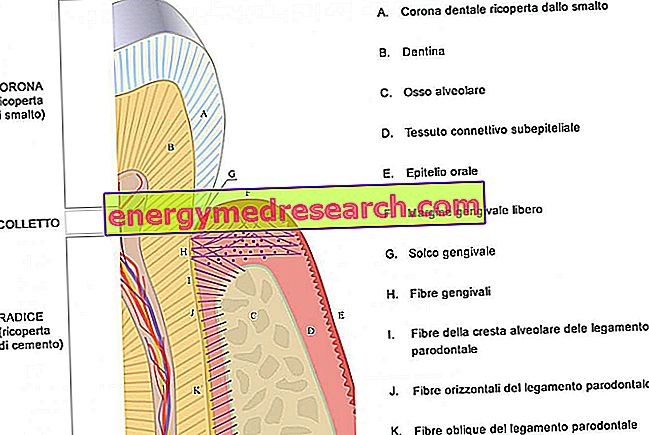
The periodontium is the set of structures that give support to the tooth.
The term derives from the Greek words parà = around and odòntos = tooth, therefore the periodontium can be considered as everything that is immediately around the tooth.
Specifically, the periodontium is formed by:
- gums: a set of soft tissues surrounding the teeth and covering the alveolar bones; close to the collar the gum forms a small invagination called gingival sulcus;
- periodontal ligament: surrounds the roots of the teeth, anchoring them with its fibers to the surrounding bone (called alveolar bone); it is otherwise known as alveolar-dental ligament;
- root canal cement: it is a very resistant calcified tissue which constitutes the outer covering of the tooth root; on it are inserted the fibers of the periodontal ligament;
- alveolar bone: it is the bone tissue that is found around the teeth.
The periodontium is also known as a periodontal, periodontal tissue, a supporting tissue for the teeth or an attachment apparatus.
The main function of the periodontium is to keep the teeth attached to the jaw bone tissue and to cushion the mechanical stresses on the dental elements (eg during chewing). Furthermore, the periodontium is important to preserve the superficial integrity of the masticatory mucosa of the oral cavity.
With regard to the shock-absorbing effect of the periodontium, it is necessary to consider that the tooth is not "plastered" inside the alveolar bone, but simply housed in it and strongly stabilized by the fibers of the periodontal ligament; the minimal elasticity of these connective fibers allows the stressed tooth to perform micro-shifts. Suffice it to say that an average of 28, 000 fiber bundles are inserted into 1 mm2 of cement.
It is then necessary to think of the periodontium as a dynamic structure, which undergoes continuous processes of transformation (turnover) and adjustment, in relation to age, but also to the chewing and the balance of the oral flora. After extraction of a tooth, for example, the underlying alveolar bone tends to retreat sensitively.
Dental hygiene and nutrition (the so-called lifestyle of the individual), aided by genetic predisposition, certainly play an important role in the onset of periodontal diseases; the most common are gingivitis and chronic periodontitis.
Periodontal tissues are richly vascularized; the supply of blood and lymph is fundamental for the turnover of gingival cells and periodontal ligament, but also for the shock-absorbing abilities of the periodontium.



